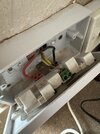- Joined
- 27 Jan 2008
- Messages
- 27,464
- Reaction score
- 3,322
- Location
- Llanfair Caereinion, Nr Welshpool
- Country

The big question is if 1.5 mm² will it make good contact? With 6 mm² not a problem, if it will not fit you can't use it.
We clearly should give the wire a tug, but when working to the clock so easy to make an error.
I remember getting about 7 boxes of sockets, 6 of which the line was one side, but one odd one line other side, no problem as when doing the testing it showed up, fitting one socket mistake would not be made, fitting 35 sockets it is so easy.
However so is not tightening terminal at all. I was called to a new build with a problem with the cordless phone, it was just to show willing, however it seems the supplier had popped the MCB's into the consumer unit, and the electrician had not checked tightness of screws clamping bus bar, yes there is a note to say installer should test all terminals, but if you don't fit it, one does not automatic test for torque.
We clearly should give the wire a tug, but when working to the clock so easy to make an error.
I remember getting about 7 boxes of sockets, 6 of which the line was one side, but one odd one line other side, no problem as when doing the testing it showed up, fitting one socket mistake would not be made, fitting 35 sockets it is so easy.
However so is not tightening terminal at all. I was called to a new build with a problem with the cordless phone, it was just to show willing, however it seems the supplier had popped the MCB's into the consumer unit, and the electrician had not checked tightness of screws clamping bus bar, yes there is a note to say installer should test all terminals, but if you don't fit it, one does not automatic test for torque.

